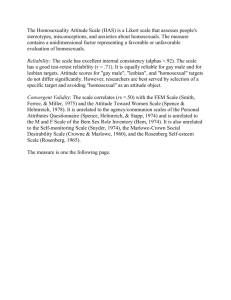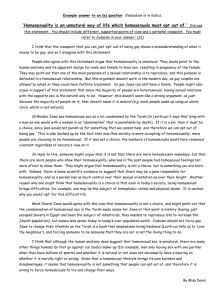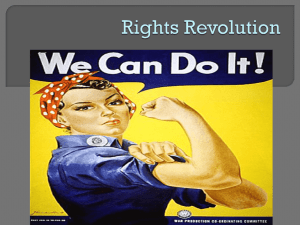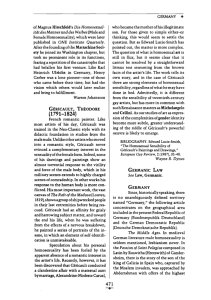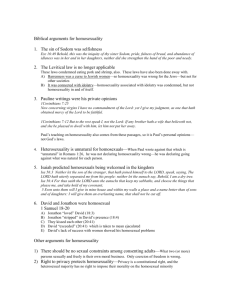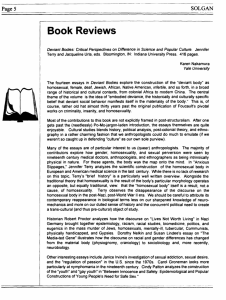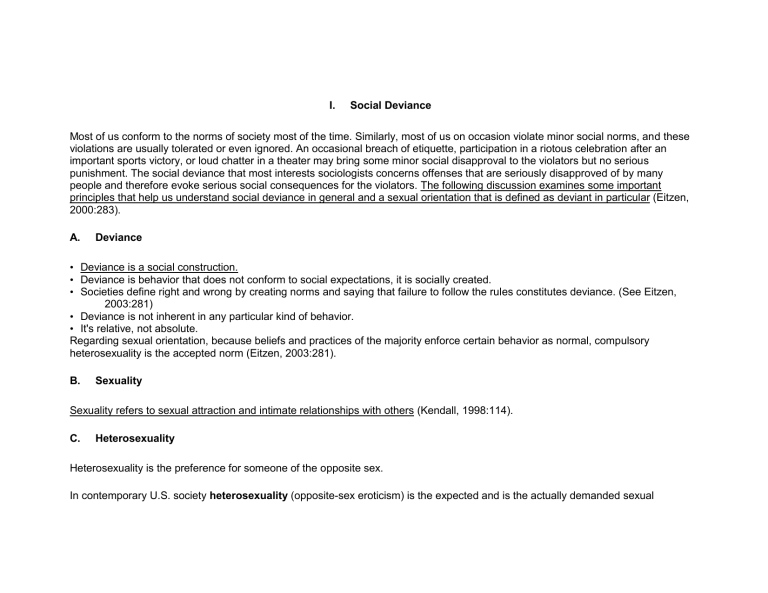
I.
Social Deviance
Most of us conform to the norms of society most of the time. Similarly, most of us on occasion violate minor social norms, and these
violations are usually tolerated or even ignored. An occasional breach of etiquette, participation in a riotous celebration after an
important sports victory, or loud chatter in a theater may bring some minor social disapproval to the violators but no serious
punishment. The social deviance that most interests sociologists concerns offenses that are seriously disapproved of by many
people and therefore evoke serious social consequences for the violators. The following discussion examines some important
principles that help us understand social deviance in general and a sexual orientation that is defined as deviant in particular (Eitzen,
2000:283).
A.
Deviance
• Deviance is a social construction.
• Deviance is behavior that does not conform to social expectations, it is socially created.
• Societies define right and wrong by creating norms and saying that failure to follow the rules constitutes deviance. (See Eitzen,
2003:281)
• Deviance is not inherent in any particular kind of behavior.
• It's relative, not absolute.
Regarding sexual orientation, because beliefs and practices of the majority enforce certain behavior as normal, compulsory
heterosexuality is the accepted norm (Eitzen, 2003:281).
B.
Sexuality
Sexuality refers to sexual attraction and intimate relationships with others (Kendall, 1998:114).
C.
Heterosexuality
Heterosexuality is the preference for someone of the opposite sex.
In contemporary U.S. society heterosexuality (opposite-sex eroticism) is the expected and is the actually demanded sexual
orientation. Thus, the term compulsory heterosexuality applies; that is, within U.S. society the beliefs and practices of the majority
enforce heterosexual behavior as normal, while stigmatizing other forms of sexual expression.
D.
Homosexuality
homosexuality is the sexual preference for someone of the same sex.
E.
Bisexuality
Bisexuality is the attraction to both sexes. In U.S. society being homosexual or bisexual is evidence of moral weakness or
pathology. Society has created homosexuality as deviance.
F.
Master Status
The status of a person is an identification. An individual has many statuses-male, student, adolescent, sociology major, Latino,
athlete, son, and brother. When one status dominates the others in an interaction, it is called a master status.
The status that defines one as a minority (race/ethnicity, gender, deviance) tends to be a master status because it is the one that
determines how people are evaluated and treated by other people. "Sex is one of the several 'master status-determining
traits.' Sexual orientation goes to the very heart of social and personal identity." A male physician, for example, who is known to be
gay, will find that his status of gay male supersedes his other statuses in the eyes and behaviors of other people in straight society
(Eitzen, 2003:281).
G.
Stigma
This discussion leads to a final insight about deviance -- that violators of important social norms are stigmatized. That is, deviants
are not only believed to be different from so-called "normal" people, but they are also set apart by being socially disgraced. The
society-through the church, the medical community, and the law-stigmatizes gays as sick, sinful, criminal, and despicable. In the
community they are pejoratively labeled as "queers," "dykes," "fags," and "fairies." This societal/community reaction to gays has
several consequences for them (Eitzen, 2000:286).
The negative reaction to gays may keep many of them invisible, will drive those open about their sexuality into gay ghettos, and
may cause extreme personal distress.
• In the latter instance, gays may accept society's negative label and consider themselves as sinners, criminals, and sick; therefore,
in need of help. The opposite may also occur:
• People labeled as outsiders may reject the dominant rules and regard those who judge them so harshly and unfairly as the
problem (Eitzen, 2000:286).
II. The Gay and Lesbian Community: An Overview
Homosexuality has become more visible in U.S. society in the past 25 years or so. This emergence of homosexuality into the
mainstream of society has generated new questions about how homosexuality should be labeled and defined. The terms sexual
preference and sexual orientation are both used to denote one's sexuality (Eitzen, 2000:286).
A.
Sexual Preference
Sexual preference implies a sense of choice regarding the sex of people to whom one is attracted (Eitzen, 2003:283).
B.
Sexual Orientation
Sexual orientation implies a deterministic view of sexual proclivities (Eitzen, 2000:286).
III.
Perspectives on Sexual Orientation
A.
Biological and Psychological Perspectives
1.
Biology
Kendall (1998:124) calls attention to evidence which suggests that sexual orientation may be partially linked to genetic inheritance.
So far that is no evidence of a "gay gene."
2.
Psychology
Psychologists link homosexuality with mental processes and childhood experience.
a.
Freud
Sigmund Freud, for example argued that people are predisposed to bisexuality in that they have a masculine and a feminine
side. He contends that over time children move into adulthood as heterosexuals. Not everyone, however, makes it completely
down the road. Later psychologists, following Freud tend to link heterosexuality with "good" mental health while homosexuality is
linked with mental illness (Kendall, 1998:124).
b.
Mental Illness
The American Psychological Association has historically linked homosexuality with mental illness. In 1942 their suggested cure
was castration or electroshock therapy (Kendall, 1998:24). Eitzen (2003:293) suggests that others called for prefrontal
lobotomy. Other "cures" called for behavioral conditioning.
c.
Gender Conforming
Other psychologists, like Daryl J Bem, explore the interaction between genetic factors and gender roles in childhood.
• He argues that children are raised to feel similarity with people of their own sex and different from children of the opposite sex.
• He argues that the belief that the opposite sex is different translates into heterosexual desire. He goes on to note that some
children see themselves as more similar to children of the opposite sex (e.g., boys who don't like to play physical sports in
lieu of playing with dolls).
• Bem contends that the best predictor of sexual orientation is the degree to which children are gender conforming. Bem offers as
proof the fact that two-thirds of gay men did not enjoy activities typical of their own gender.
B. Interactionist Perspectives
The Interactionist explore how children learn behavior and how they come to identify themselves as gay or straight.
Interactionist identify three stages in the process of accepting the identity of gay.
1. There is identity confusion in that the individual feels different from other people.
2. The next stage is seeking out others who are openly homosexual and perhaps engaging in sexual experiments.
3. People attempt to integrate their self-concept and acceptance of the label homosexual.
C. Functionalist Perspectives
According to the functionalists, social norms exist to preserve social institutions and maintain stability in society. Homosexuality
violates theses norms. According to functionalist marriage and family are necessary for the continuation of society. Homosexuality
undermines those arrangements (Kendall, 1998:126). In the extreme, if homosexuality were to become a norm, the production of
offspring would be threatened. This is a justification for the resistance of allowing homosexual marriage.
D.
Conflict Perspective
Critics of the functionalist argue that it supports the status quo at the expense of exploring new definitions of family and marriage. If
for example, we define marriage as the decision of two people to live together in a partnership, then the issue of having children is
mute.
Conflict theory explores the tensions and differences in interests and power among existing groups. People who hold power are
able to see that their view of society is seen as appropriate and they have the power to see that their concept of reality is enforced.
IV.
Discrimination Based on Sexual Orientation
Gays confront three types of oppression: (1) ideological, in which their behaviors are defined and stigmatized as immoral; (2) legal,
where their activities are defined as illegal or they are treated unfairly by the courts and other agents of control; and (3)
occupational, where jobs, advancement, and income are restricted or denied (Eitzen, 2000:290).
A.
Ideological Oppression
1.
Homophobia
Homophobia is fear and hatred of homosexuality. It shares many of the same roots with other prejudices. Like racism and antiSemitism, homophobia includes
• "an intolerance toward otherness; a fear of lives, perspectives, and practices that one doesn't understand;
• and a visceral desire for a social hierarchy that puts some people on the social rungs below themselves" (Eitzen, 2000:291).
2. Religion
The Judeo-Christian tradition considers homosexual behavior a heinous sin. The Old Testament approves of sexual intercourse
only within marriage and for the purpose of procreation. Homosexuality has, therefore, been expressly forbidden.
The New Testament continued this tradition. The early Christians strived for human perfection unencumbered by the desires of the
flesh included the condemnation of homosexuality. Contemporary Christian churches and denominations have varied in their
response to the homosexual issue. Some, perhaps the majority, reject homosexuality and consider it a sin.
• The Reverend Jerry Falwell, fundamentalist preacher and founder of the Moral Majority, for example, called the outbreak of AIDS
among homosexuals a "form of judgment of God upon a society."
• The Reverend Pat Robertson, television evangelist, said in 1998 that the widespread practice of homosexuality will bring God's
wrath: "[it will bring about terrorist bombs, it'll bring earthquakes, tornadoes and possibly a meteor."
• Pastor Peter J. Peters asserts, "The truth is, the Bible advocates discrimination against, intolerance of and the death penalty for
homosexuals."
Quakers are more accepting of homosexuality than Catholics, Christians, or Jews. (Eitzen, 2003:29
B.
Legal Oppression
In fourteenth-century Europe the common punishment for homosexuality was burning at the stake. The Puritans in the colonies
continued the death penalty for this "crime." Around the time of the American Revolution, Thomas Jefferson and some liberal
reformers of the day proposed changing Virginia law, replacing the death penalty for homosexuality with castration (Eitzen,
2000:295). The legal status of homosexuals has progressed considerably since the days of death and castration, but gays
continue to experience unequal treatment under the law.
1.
Sodomy Laws
Prohibitions against sodomy (oral or anal sex) were universal in the United States until 1961, when Illinois became the first state to
repeal its sodomy law. Other states followed, but 23 states still have sodomy laws. In 1986 there was a constitutional challenge to
sodomy laws. The argument in this challenge was that sexual activity between consenting adults in private is not questioned, let
alone regulated, even in states with laws prohibiting sodomy, provided the adults are heterosexual. In short, sodomy laws are used
to harass homosexuals, especially gay men, because women in general and lesbians in particular are socially invisible in society
(Eitzen, 2000:295)
2.
The Military
The armed forces have always discriminated against gays and lesbians. From 1982 to 1992 about 14,000 people were
dishonorably discharged from the military as homosexuals. According to Defense Department statistics, women are three times
more likely to be removed for homosexuality than are men (Eitzen: 2006:200).
Don't Ask - Don't Tell
In 1993 newly elected President Clinton vowed to change the regulations so that homosexuals would not be discriminated against
in the military. This proposal was resisted by many citizens, politicians, military leaders, and military personnel. The result was a
compromise-the "don't ask, don't tell" rule. This meant that the military was not to ask their personnel about their sexuality, and to
prosecute only if gay and lesbian service members were blatant about their sexual orientation. In short, as long as homosexual
service members "stayed in the closet," they were supposedly allowed to be in the military (Eitzen, 2006:300).
In reality, more than 10,000 people have been discharged from the military since "don't ask, don't tell" went into effect. Lately
however, as the Iraq War has intensified the need for military personal, the number of gays discharged as decreased.
3.
Family Rights
a.
The Lack of Marital Rights
State laws tend to affirm homophobia because they formally condemn living arrangements among homosexual couples. Laws
banning same-sex marriages convey a message of intolerance, saying, in effect, that those couples are neither legitimate nor
respected (Eitzen, 2006:301).
In the United States, many gay or lesbian couple cohabit because they cannot enter into a legally sanctioned marriage
Cohabitation is a living arrangement where two unmarried adults living together in a sexual relationship without being legally
married (Kendall, 1998:118).
b.
Domestic Partnership
Several counties and cities also recognize "legal domestic partners," including San Francisco; New York City; Seattle; Santa Cruz,
California; West Hollywood; Boulder, Colorado; and Madison, Wisconsin. This status of "domestic partners" permits partners to
receive limited spousal benefits. In New York City, for example, a gay or lesbian may inherit an apartment lease if a partner dies
(Eitzen, 2000:297).
Over the past few years some cities and states have given legal recognition to domestic partnerships.
Domestic partnerships are living arrangements where household partnerships in which an unmarried couple lives together in a
committed, sexually intimate relationship and is granted the same rights and benefits accorded to heterosexual couples (Kendall,
1998:118-119).
Domestic partnership arrangements allow homosexuals to benefit from employment benefits that are offered to spouses such as
medical coverage. Kendall (1998:119) notes that these domestic partnership recognition also allows other, not gay, couples to
benefit.
Domestic partnership laws are none-the-less limiting in that they do not allow for the following:
• joint parenting of children
• filing of joint income tax returns
• immigration of partners from other countries
• sharing of benefits from annuities and pensions
• surviving partners to have access to social security benefits
• immunity from testifying against your partner in court.
c. Parental Rights
Parenthood has become the newest battleground for lesbian and gay rights. The legality of homosexual parenthood varies from
state to state, and the interpretation of the law often varies from judge to judge (Eitzen, 2000:298).
1.
Adoption
In some states, homosexual couples can adopt children. In 1994 the Massachusetts Supreme Court ruled that there was nothing in
the state law to prohibit adoption by a gay or lesbian couple even though the state does not recognize same-sex marriages. In other
states, it is illegal. As a result, there are only a few hundred documented cases of adoption by openly homosexual couples. Of
course, many adoptions occur where a single person seeks the adoption while concealing her or his homosexuality (Eitzen,
2000:298).
2.
Child Custody
Another situation is custody of children following a heterosexual marriage. In such a situation judges routinely give custody to the
heterosexual parent, assuming that this arrangement is better for the child. In 1994 a Virginia judge ruled that the biological mother
could not have custody of her child because she was now in a lesbian relationship and therefore an unfit parent (Eitzen, 2000:298).
Some lesbians achieve parenthood through artificial insemination. The trick with this arrangement is for the partner of the mother to
achieve legal status through adoption. Presently only eight states permit a lesbian to adopt her lover's child and become a second
parent (Eitzen, 2000:299).
4.
Police Action.
Although the rate and kind of harassment vary from jurisdiction to jurisdiction, the police use a variety of techniques to harass
homosexuals. They may use questionable means to apprehend and arrest homosexuals (for example, filming sexual interactions
through one-way mirrors installed in public restrooms, wiretapping telephones, and using decoys to entrap) (Eitzen, 2006:304).
a.
Bars and sodomy Laws
Bars where homosexuals gather are frequently raided for suspected violation of the sodomy laws.
Patrons in these raids may be photographed and fingerprinted, which is particularly frightening to people who wish to keep their
homosexual orientation private.
The owners of these establishments are harassed by public authorities who may, for example, revoke their liquor license or issue
citations for inconsequential or even nonexistent building code violations. In effect, the agents of social control in many communities
have an unofficial policy that encourages the harassment of deviant groups, of which homosexuals are considered by many to be
the most abhorrent (Eitzen, 2000:299).
b.
Police Inaction
Police inaction, negatively affects gays through their response to gays as victims of violence. There is evidence that homosexuals
are the most frequent victims of hate-motivated violence (assault, verbal intimidation, and vandalism), more so than African
Americans, Latinos, Southeast Asians, or other minority groups. Only a few police and sheriff's departments have made bias crime
a priority, however, and even fewer have expanded their jurisdiction to include antigay violence (Eitzen, 2000:300).
C.
Occupational Discrimination
The exact amount of job discrimination against homosexuals is unknown, primarily because the government does not provide gay
employment discrimination statistics, as it does for women, African Americans, and other minorities (Eitzen, 2000:300).
Many homosexuals fear that they will lose their jobs if their sexual orientation is revealed.
Or, if not fired, they may experience other forms of discrimination, such as being passed over for deserved promotions, being given
relatively low salary raises, and being harassed. These fears are likely based on reality. The New York State Health Code includes
a section, for example, that states that employees can be fired for moral turpitude (which includes homosexuality as such a case)
(Eitzen, 2000:300).
Homosexuals are more likely to have a police record. The process of applying for a job is more problematic for homosexuals than it
is for other people. The application form may ask if the applicant has ever been arrested, and if so, why. Because the laws
criminalize homosexuality in many jurisdictions, homosexuals are more likely than heterosexuals to have a police record. Gays and
lesbians are thus caught in a double bind. If, on the one hand, they disclose their arrest for homosexual behavior, they will be
denied a job. On the other hand, if they conceal this fact, they will be fired for lying. Finally, if applicants voluntarily disclose their
homosexuality on the application, they are not likely to be hired (Eitzen, 2000:301).
V.
Fighting the System: Human Agency
Homosexuals use two basic strategies for living in a society hostile to their sexual orientation.
A.
Secret Gays
One strategy is to conceal their sexual orientation from straights to avoid stigmatization, harassment, and discrimination. These
secret gays segregate their lives into gay and straight activities. When in the straight world, they conceal their sexual orientation
from family, friends, co-workers, and other associates.
Those most likely to stay in the closet are from the working classes. The structural and personal pressures against coming out are
much greater for them than for those from the middle and upper classes (Eitzen, 2000:302).
B.
Activists
Gay activists, on the other hand, identify themselves openly as homosexuals. Rather than evade the efforts of straights to
stigmatize them, they challenge society in an effort to transform it (Eitzen, 2000:302).
1.
The Sixties
The 1960s provided a better climate for change when youths, African Americans, women, pacifists, and other groups questioned
the norms and ideologies of the dominant society. This decade clearly was one of heightened awareness among the oppressed of
their oppression and of the possibility that through collective efforts they could change what had seemed to be unchangeable
(Eitzen, 2000:303).
2.
The Stonewall Raid
The precipitating event for homosexual unity occurred at 3 A.M. on June 28, 1969, when police raided the Stonewall Inn of New
York's Greenwich Village. But instead of dispersing, as homosexuals had always done in similar situations, the 200 homosexual
patrons threw objects at the police and set fire to the bar. The riot lasted only 45 minutes, but it gave impetus to a number of
collective efforts by gays to publicize police harassment of the gay community, job discrimination, and other indignities they faced.
In effect, the Stonewall resistance came to symbolize the birth of the modern gay rights movement (Eitzen, 2000:303).
3.
Gay Liberation Movement
Following Stonewall, gay liberation groups emerged in many cities and on university campuses. Many neighborhoods in major cities
became openly homosexual-most notably the Castro district in San Francisco, New Town in Chicago, and Greenwich Village in
New York City. These communities included gay churches, associations of professionals, health clinics, and networks of gay-owned
businesses to supply the gay community's needs. The proliferation of these organizations for homosexuals has provided a
supportive climate, allowing many of them to come out of the closet (Eitzen, 2000:303).
4.
Decades After Stonewall, Many Positive Changes
a. At the time of Stonewall, 48 states had sodomy laws meant to outlaw homosexual sex. Now 23 states had such laws.
b. In 1969 no state or local government had a law protecting the civil rights of homosexuals. In 1996 the Supreme Court in Romer v.
Evans ruled that states and municipalities had the right to protect gays from discrimination.
c. The Supreme Court in 1998 ruled unanimously that sexual discrimination in the workplace applies to harassment between
workers of the same sex. This ruling gives civil rights protections to all employees, male or female, homosexual or
heterosexual, something unheard of in 1969
d. In 1994 more than 11,000 athletes from 44 countries competed in Gay Games IV in New York City, an event beyond imagination
in 1969 (Eitzen, 2000:305).
Bibliography
Eitzen, D. Stanley and Maxine Baca-Zinn
2000 Social Problems. (8th Ed.) Boston: Allyn and Bacon.
2003 Social Problems. (9th Ed.) Boston: Allyn and Bacon.
Kendall, Diana
1998 Social Problems in a Diverse Society. Boston: Allyn and Bacon.

